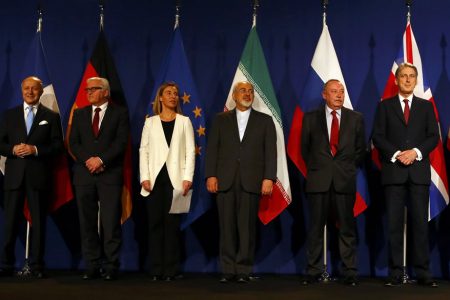President Donald Trump has very robust plans to "rebuild" America’s defenses. He wants to add about 100,000 more ground forces; expand the Navy from 280 to 350 ships; and provide the Air Force 1,200 fighters. These are ambitious and extraordinarily expensive aspirations. But more about that shortly.
In Brussels, speaking at a major conference, Chairman of the Senate Armed Services Committee and one of America’s top defense experts, Sen. John McCain, made the extraordinary remark that he and Trump had not met even once to discuss the administration’s plans for increasing the nation’s military forces. How can that be? After all, one of the campaign promises beyond "repeal and replace Obamacare:" "build a wall;" and bring millions of jobs back to America was "to rebuild defense."
One would have thought that the president realized the critical importance of having Congress on board in passing legislation. That did not happen with healthcare. It appears this failure will repeat with defense. Clearly, Trump’s denigration of McCain during the campaign over having been shot down during the Vietnam War and held captive for five and a half years was not endearing. A meeting might have better informed the president on defense issues about which he does not appear knowledgeable and at least been an attempt to make up for his past derisive comments about McCain.
No meeting or reconciliation took place. Here is the rub. Even if this year’s defense spending is increased to $640 billion as recommended by both the House and Senate Armed Services Committees, it is vastly insufficient to fill the huge shortfalls in readiness and procurement that have accrued over the past decade. Given the trillions spent on defense for fighting the wars of the last 16 years, to many observers, it seems inconceivable the American military is in such bad shape.
For those who disagree with or are unaware of this pending crisis, the testimony of the vice-chiefs of each of the services and the combatant commanders before Congress over the past month are chilling. For example, Adm. Bill Moran, the Navy’s No. 2, told Congress that 62 percent of the Navy’s frontline F-18 fighter attack aircraft are not serviceable. The other services have similar problems.
Several factors account for these huge and growing shortfalls. First is the irrational budgeting process and continuing resolutions that mandate planning on a year-to-year rather than a long- term basis and freeze new starts. The inefficiency and waste are enormous as long-range planning is restricted to a year.
Second is the effect of the Budget Control Act that imposes ceilings on both defense and non-defense discretionary spending. When those caps are broken, cuts are divided equally between defense and non-defense line items. Worse, cuts are pro-rated equally across every program. So a 10 percent cut means 10 percent less of a ship, aircraft or a tank — a process so incredibly destructive, our enemies could only have created it. But none did. It was us.
Third and most insidious is uncontrollable internal cost growth for everything from precision weapons to people to pencils. This amounts to about 5 to 7 percent a year in real terms, meaning above inflation. The Pentagon’s Defense Business Board did sterling analysis in describing this phenomenon and warning of its impact. But no one is listening.
This cost growth amounts to the need for $30 billion to $45 billion a year more spending just to keep up and not to amend past shortfalls or add capability. Even at $640 billion, that level is less than is needed if the force is to return to earlier and higher levels of readiness and procurement. The consequence will be a repeat of the so-called post Vietnam "hollow force" when the military was unprepared, unready and ill-equipped to conduct operations.
As is well known, as technology yields greater capability, costs go up. Aircraft carriers, without air wings cost just under $15 billion each. The cost of the F-35 A is about $100 million. And its flying costs per hour for maintenance are about $80,000. Those costs will go down. But over the life cycle of the aircraft, these costs are still huge.
The Trump plan is to add about 100,000 ground forces to the Army and Marines; build the Navy from 280 to 350 ships; and increase the Air Force to about 1,200 fighters. Meanwhile, the nation must re-capitalize its nuclear deterrent with new ballistic submarines, intercontinental missiles and a new bomber. To accomplish these aspirations AND have a force that is ready, prepared and well-equipped will cost in excess of $800 billion a year. And if the uncontrollable internal costs and irrationality of the budget process continue, those costs could reach about $1 trillion a year.
Out of a GDP of $20 trillion, $1 trillion a year is only 5 percent. Out of a federal budget of just above $4 trillion, it is 25 percent. Given the huge debt of $20 trillion and the increases in entitlement spending, especially as the population ages, the impact is clear. Short of World War III, such defense spending is out of the question.
The reality and consequences are blindingly obvious. With soaring debt and deficits and interest rates that are now beginning to rise, the United States will be spending itself into oblivion. The question is not if but when. And the larger issue is why does the nation need to do this.
If the Trump administration is planning for war against China or Russia, then these budgets are far too small. In the war against jihadi extremists, the super expensive conventional military systems are not always applicable. Nor are they needed. What then is to be done?
First, the United States must appreciate that 20th century concepts such as deterrence no longer apply in the same sense. Neither Russia nor China has any intention of starting a war. Their aims are geopolitical. Hence, a counter-geopolitical strategy is needed and not one that is completely dependent on military force.
Second, a strategic black hole exists against so-called non-military or asymmetric dangers that include cyber, hacking, propaganda, misinformation, disinformation, intimidation and intrusions into internal politics. The size of the military has less utility than using other arms of government. But this black hole must be closed.
Third, uncontrollable internal cost growth in the Pentagon must be checked. Ironically, the choice is between a smaller, ready, well-trained and equipped force and a larger far more hollow force that is not prepared for its duties. No one in the White House seems to understand this conundrum. And not talking to the key and responsible leaders in Congress for defense does not help either.




